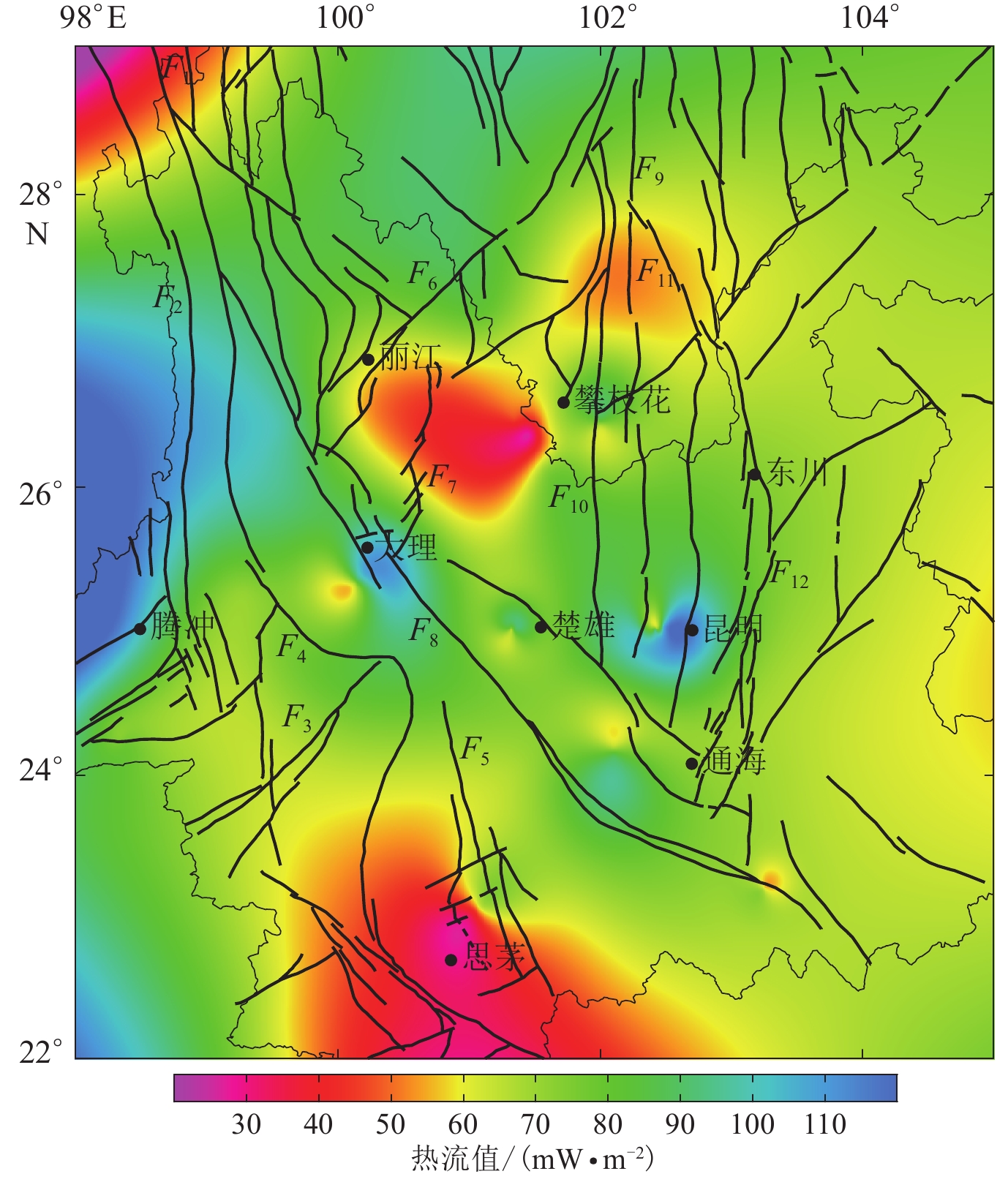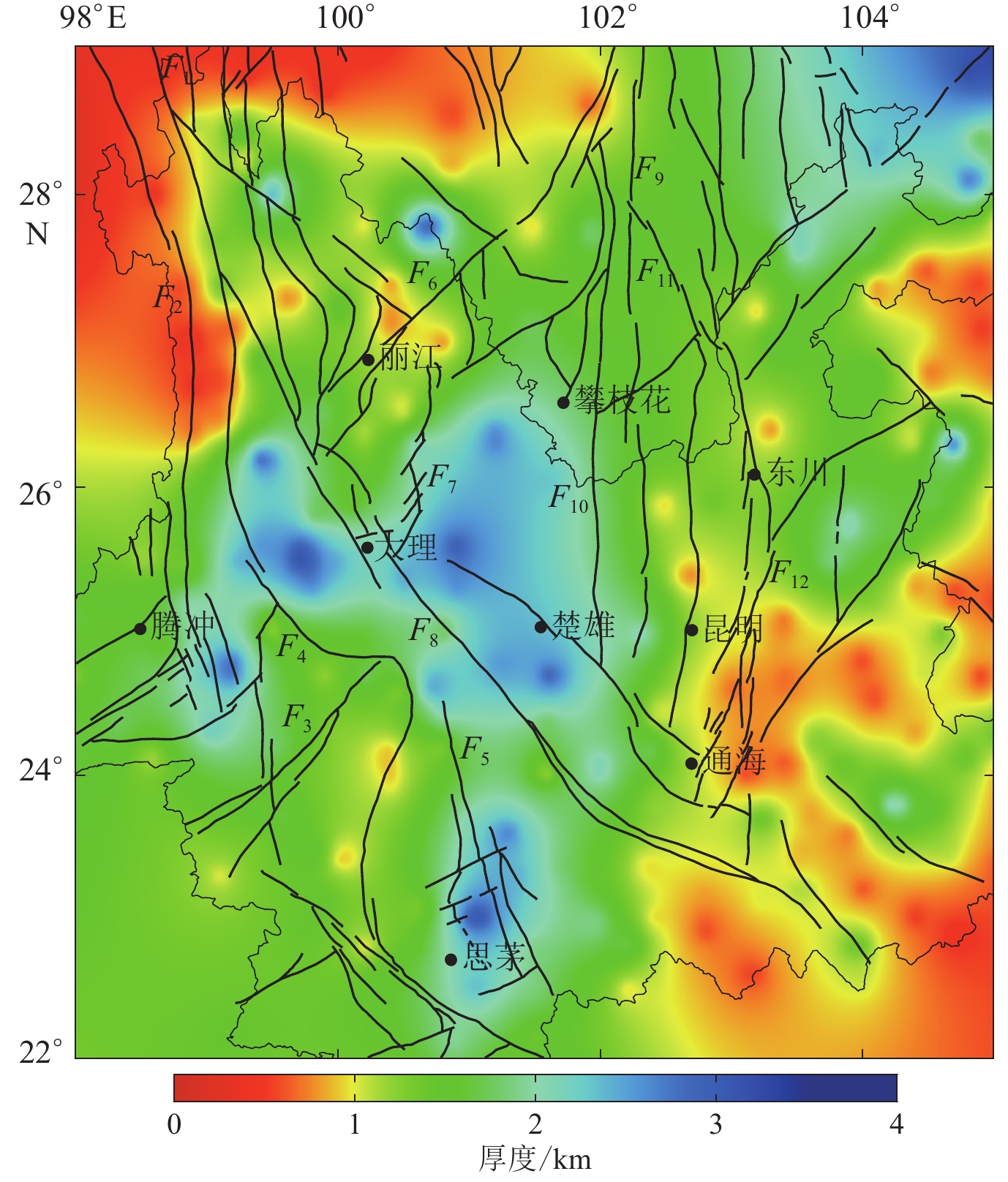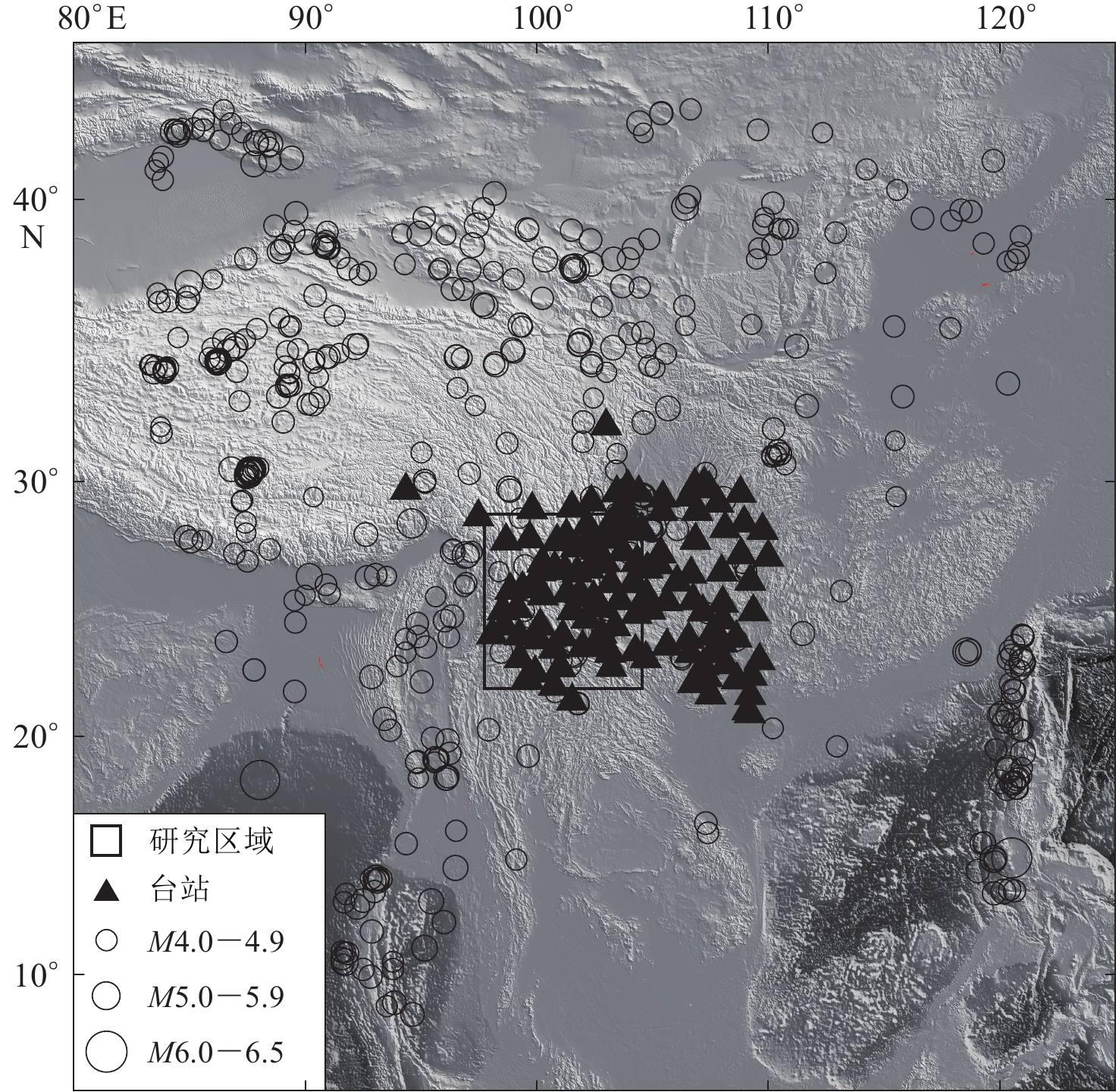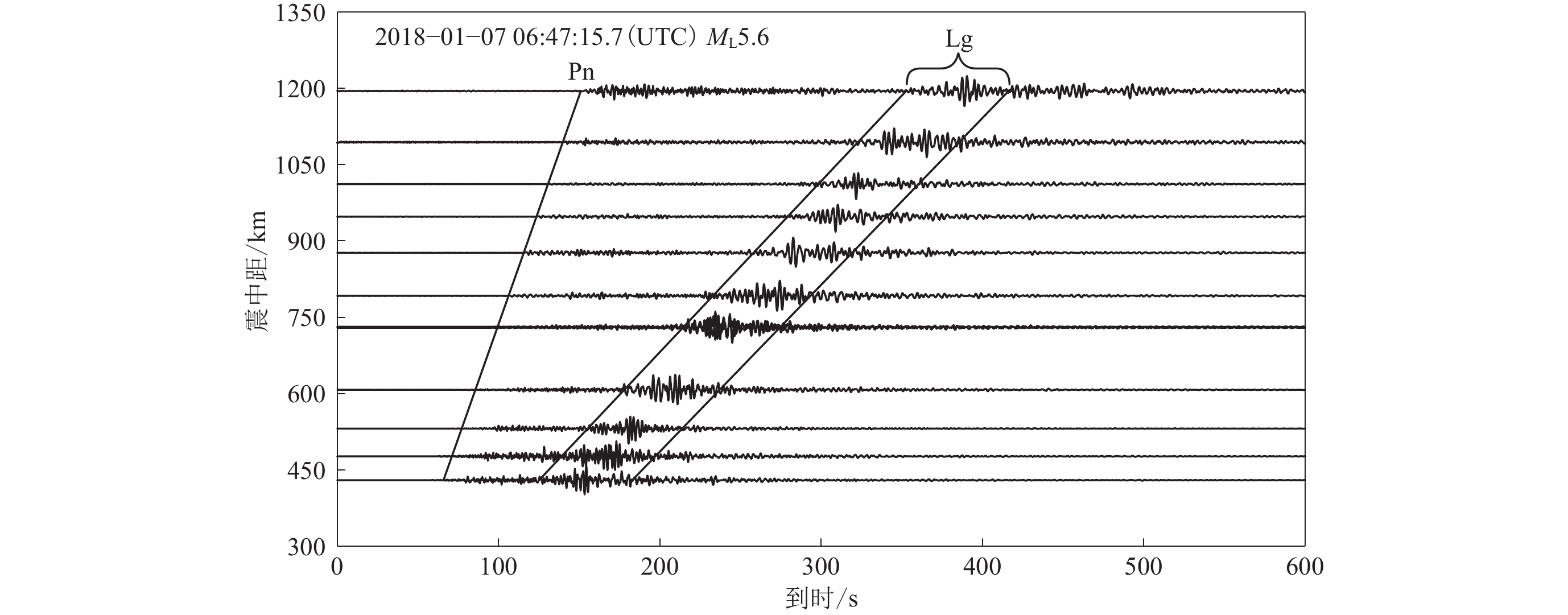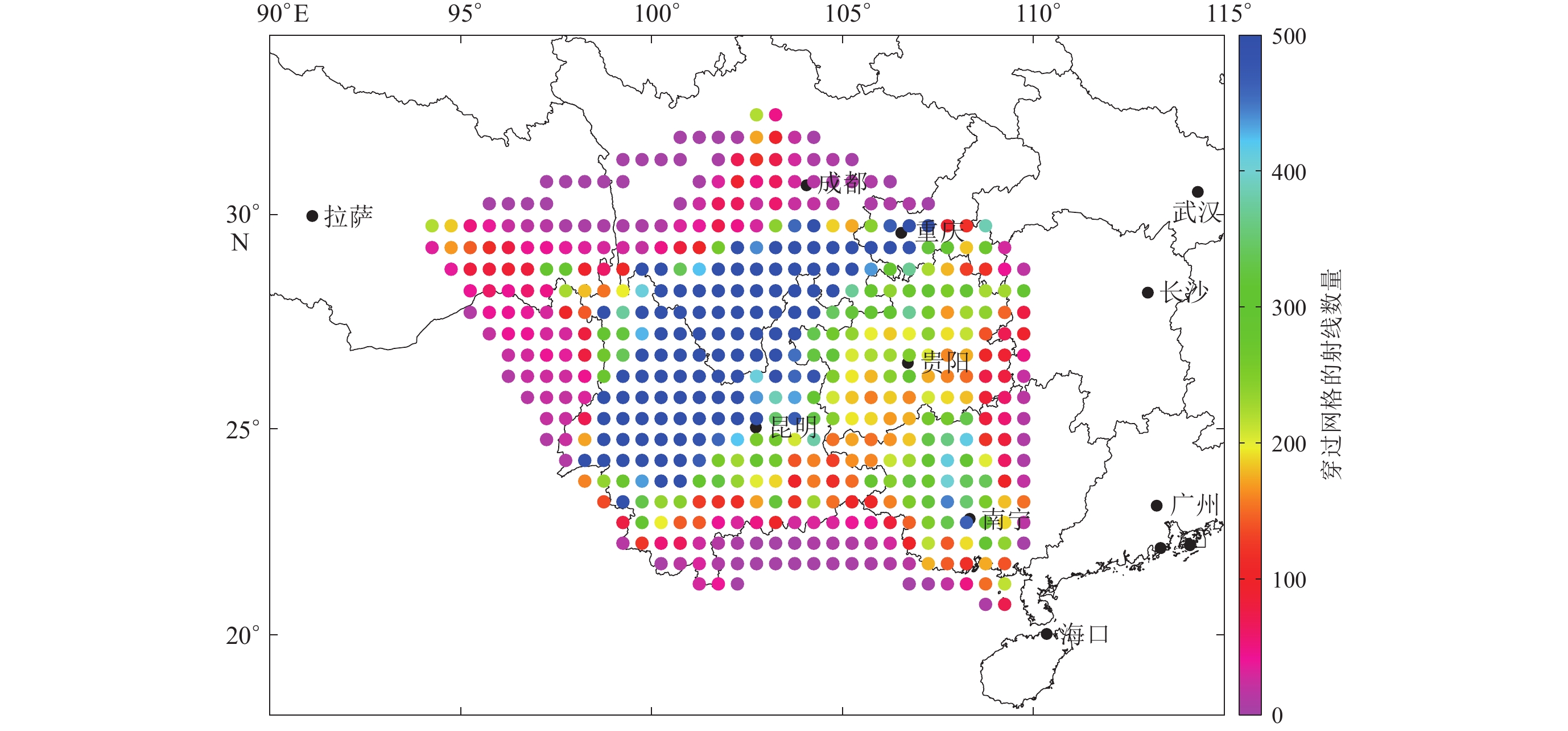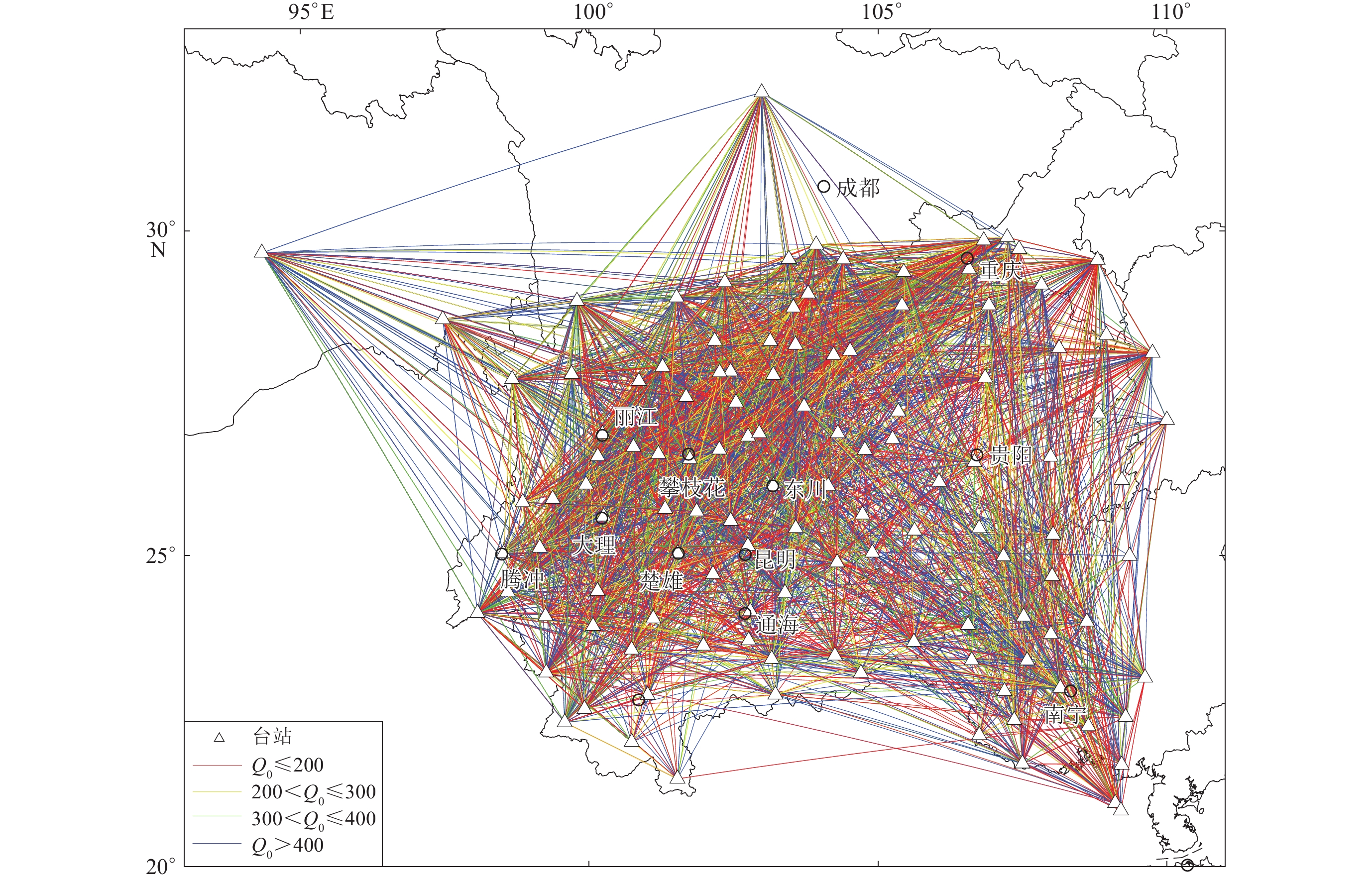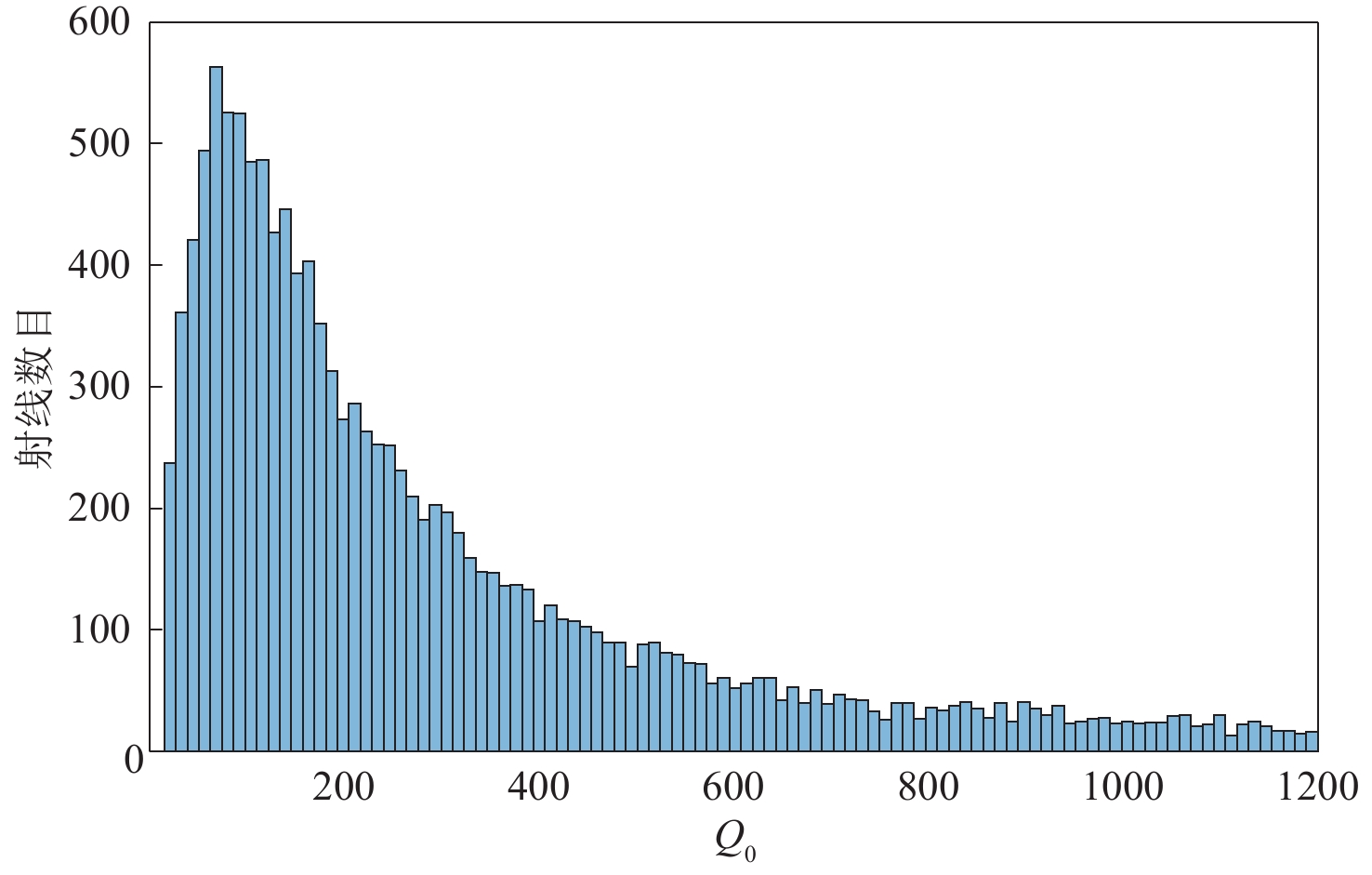Study on Lg wave attenuation imaging in Yunnan
-
摘要: 收集了云南省及周边121个固定台站于2014年5月—2019年5月记录到的470次M≥4.0宽频带地震记录,利用反双台法处理了6 976条垂直向波形数据,通过LSQR方法反演得到了云南地区的空间分辨率小于100 km的1 Hz下Lg波衰减成像。反演结果表明,云南地区地壳Lg波的Q0值介于60—300,整体为低Q0背景,横向不均匀性变化显著。云南地区低Q0值的分布特点,反映了Lg波在云南地区衰减强烈。红河断裂西侧Q0值较低,在50—160之间,东侧Q0值较高,在120—200之间,分布特征与沉积层厚度分布一致,松散的沉积层可能是造成东侧地区Lg波高衰减的主要原因。云南地区地壳Lg波Q0值呈现出了与地表热流值分布相似的差异化分布特征,这可能与频繁的地震、长期强烈的构造运动以及深部物质随火山活动上涌有关。Abstract: In this paper, 470 broadband seismic records of natural earthquakes with M≥4.0 between May 2014 and May 2019 recorded by 121 fixed stations in and around Yunnan Province are collected. 6 976 high-quality vertical wave data is processed by using the reverse two-station method. The attenuation imaging of Lg wave at 1 Hz with spatial resolution less than 100 km in Yunnan area is inverted. The inversion results show that the Q0 value of Lg wave in Yunnan is in 60 to 300 range, and the whole is in low Q0 background, with significant changes in lateral heterogeneity. The distribution characteristics of low Q0 value in Yunnan area reflect the strong attenuation of Lg wave in Yunnan area. The Q0 value in the west side of Honghe fault is relatively low, in 50 to 160 range, and in the east side is relatively high, in 120 to 200 range. The distribution characteristics are consistent with the distribution of sedimentary layer thickness. Loose sedimentary layer may be the main cause of high attenuation in the east side. The Q0 value of Lg wave in Yunnan area shows a similar differential distribution with the distribution of surface heat flow, which may be related to frequent earthquakes, long-term strong tectonic movement and deep material upwelling with volcanic activity.
-
Keywords:
- Yunnan area /
- Lg wave imaging /
- seismic wave attenuation /
- Q value /
- reverse two-station method
-
引言
安宁河断裂带位于川滇菱形地块以东,南接则木河断裂(图1)。两条断裂带共同构成川滇菱形地块和华南地块的边界带。由于地块间的相互作用,断裂系以左旋走滑运动为主,北侧鲜水河断裂北西西向的走滑运动被南北走向的安宁河—则木河以及相邻的大凉山等断裂吸收,造成该区地震多发(易桂喜等,2008;张培震,2008;祝爱玉等,2015)。以往应用GPS的断层闭锁研究显示,川滇菱形地块东边界整体左旋走滑速率较高(赵静等,2015;Jiang et al,2015;宋剑等,2016;朱良玉,蒋锋云,2018)。这使得安宁河断裂能量积累较快,且多以地震的形式释放能量(程佳等,2011)。该区也成为地震危险性研究的热点地区(吴微微等,2017;徐晶等,2019;Cheng et al,2021)。
断层滑动速率是研究断裂带地震危险性的关键指标之一(李姜一等,2020;李乐等,2021)。通过GPS速度场反演断裂带运动速率是目前滑动速率研究的主要方法。GPS数据具有精度高,观测尺度大的优势。然而基于GPS得到的断层滑动速率仅体现了断层在地表的运动,其深部运动可能与地表存在差异。并且由于安宁河断裂带区域观测条件恶劣,难以获得高分辨率的形变观测数据(李姜一等,2020)。而重复地震相关研究的发展,为断裂带深部运动提供了新的研究途径(Nadeau,McEvilly,1999)。重复地震被定义为发生在断层相同位置,波形和震源机制高度一致的一组地震事件。有研究认为凹凸体的重复破裂产生重复地震(Uchida,Bürgmann,2019),利用重复地震研究凹凸体的时空变化,可获得断层深部运动行为(孙庆山,李乐,2018)。重复地震的这种特性使其成为研究断层深部滑动速率的有效手段。
目前重复地震已被广泛应用于断层深部滑动速率的研究(Li et al,2007,2011;李乐等,2008,2013,2015;李乐,陈棋福,2010;高朝军等,2017;孙庆山,李乐,2020;Zhang et al,2022)。发生在断层相同位置是重复地震的基本特征。在波形互相关的基础上,计算地震破裂半径并通过地震精定位确保地震破裂面重叠是识别重复地震的有效手段(Li et al,2007)。断层深部滑动速率的研究需对微小地震事件进行重复地震识别,多数地震破裂半径仅为数十米。当台站分布不均匀时,定位精度难以满足重复地震识别条件(王伟涛,王宝善,2011)。对此,Li等(2011)提出了利用S−P相对到时差约束地震相对位置的方法,并将该方法应用于龙门山断裂、小江断裂、鲜水河断裂、红河断裂等地区的重复地震识别和深部滑动速率研究中(Li et al,2011;李乐等,2013,2015,2021;孙庆山,李乐,2020)。该方法解决了由于台站稀少和分布不均匀导致的定位精度不足问题。然而利用震相走时残差约束地震相对距离的方法对震相到时的准确度要求较高,提高震相拾取精度是保证重复地震识别可靠性的关键。
2013年至2019年间,布设在安宁河断裂带地区的西昌流动宽频带地震台阵(图1)积累了丰富的地震波形资料。西昌台阵和周边固定台对安宁河断裂带形成良好的覆盖,为本研究提供了有力的数据支撑。本文拟利用波形互相关方法对相似地震进行识别,并对震相到时进行校正,以保证震相拾取的可靠性;随后利用S−P相对到时差约束地震相对位置,筛选重复地震;最后利用重复地震计算安宁河断裂带及周边地区的深部滑动速率,并结合研究区已有研究成果进行讨论,以期为该区断层结构和地震危险性研究提供参考。
1. 数据和方法
1.1 数据
本研究搜集了2013年至2019年西昌台阵和周边固定台记录的地震波形数据和震相报告。其中西昌台阵由33个宽频带流动地震台站组成,平均台间距约20 km (图1)。选择区内固定台14个,与西昌台阵相结合共同对研究区内断裂带和近震事件形成良好的覆盖。研究整理得到地震事件共1万3833次,图1展示了研究区内近震事件位置和震级的分布情况。波形记录的采样率为100 Hz,选取ML1.0以上地震事件,共4342个以确保波形质量和结果的可靠。同时对波形进行1—10 Hz的带通滤波(Ma et al,2014)。
1.2 重复地震识别
发生在断层相同位置的重复地震在同一台站接收到的波形具有高度一致的震源机制和传播路径,波形通常相似(Uchida,Bürgmann,2019),因此波形互相关方法是识别重复地震的有效手段。本文采用波形互相关方法对相似地震进行识别。基于地震事件可靠性和计算速度的考量,仅对有四个及以上相同台站记录到的地震对进行互相关计算。将地震对的波形三分量均加入到计算过程中。其中垂直分量截取直达P波前后2 s,两水平分量截取直达S波前2 s和后4 s (宿君,2020)。由于用到的P波和S波震相直接读取自震相报告,为了保证震相到时准确,采用滑动时窗互相关的方法对震相到时进行校正;然后计算波形相关系数;最后取三分量相关系数的平均值作为互相关计算结果。当一对地震事件存在一个台站相关系数大于0.9时,即可判定为相似地震对(Schmittbuhl et al,2016;Hayward,Bostock,2017)。
波形相关系数不仅受地震相对位置影响,诸如台站方位角、震中距、速度结构等因素也会影响互相关结果(Gao et al,2021)。因此仅靠波形相似不足以判断是否为重复地震。由重复地震定义可知,地震破裂面积的重叠是判断重复地震的重要指标,根据圆盘破裂模型(图2),当地震相对距离dx小于地震对破裂半径ri与rj之和,即dx<ri+rj时,可认为地震对破裂面积重叠。因此有必要约束地震相对位置和估算破裂半径。
![]() 图 2 地震对破裂面重叠示意图(修改自 Li et al,2011)Figure 2. Overlap of the source ruptures (modified from Li et al,2011)
图 2 地震对破裂面重叠示意图(修改自 Li et al,2011)Figure 2. Overlap of the source ruptures (modified from Li et al,2011)对于识别到的相似地震对,可依据Kanamori和Anderson (1975)给出的地震矩经验关系式
$$ {M}_{0}=\frac{16}{7}\Delta \sigma {r}^{3} $$ (1) 估算破裂半径,式中:$ {M}_{0} $为标量地震矩,可通过Abercrombie (1996)给出的地方震级与地震矩的关系式估算,即
$$ {\mathrm{l}\mathrm{g}M}_{0}=9.8+{M}_{\mathrm{L}} ;$$ (2) $ \Delta \sigma $代表应力降,其值参考以往川滇地区应力降研究成果取固定值4.5 MPa (孙吉泽,2019);r为破裂半径。
由于本研究识别出的相似地震多分布于台阵边缘,台阵分布难以保证地震定位精度。因此采用S−P相对到时差约束地震相对位置(Li et al,2011),而且我们已通过互相关方法对P,S波到时差进行了校正,相似地震对的相对距离$ {\rm{d}}x $则可利用校正后的P波和S波相对到时差$ \Delta {t}_{\mathrm{S}-\mathrm{P}} $进行约束,两者关系为
$$ {\rm{d}}x=\frac{{v}_{\mathrm{P}}\Delta {t}_{\mathrm{S}-\mathrm{P}}}{\gamma -1}, $$ (3) 式中,$ {v}_{\mathrm{P}} $为P波速度,$ \gamma $为P与S波速比。根据李乐等(2015)在鲜水河断裂进行的重复地震研究,取$ {v}_{\mathrm{P}} $=6.0 km/s,$ \gamma $=1.7。由式(3)即可得到地震相对距离$ \mathrm{d}x $。同时,由于本文单独对P,S震相计算互相关,可能存在相关系数高但P,S波相对到时差相差较大的相似地震对。这种方法可同时将P,S波到时差相差较大的相似地震对筛掉,使结果更为可靠。
上文所得相似地震对中符合dx<ri+rj条件即可判定为重复地震对。最后,共得到705对重复地震对。重复地震对之间有事件重叠的可划分为重复地震组。将重复地震对进一步划为289组重复地震组。为了计算断裂带深部年平均滑动速率,删除持续时间小于一年且事件个数不足三个的组,最终得到10组重复地震,列于表1。
表 1 10组重复地震及其对应的深部滑动速率Table 1. Deep slip rate computed from 10 repeating earthquake groups地震组 发震时间(UTC) 北纬/° 东经/° 震源深度/km 事件次数 ML 滑动速率/(mm·a−1) 年-月—年-月 S01 2013-05—2014-09 29.841 9 102.413 0 14.155 3 3 1.4—1.8 4.37±0.65 S02 2013-06—2014-11 29.844 7 102.417 7 5.167 0 3 1.5—2.4 5.13±2.95 S03 2014-05—2017-11 27.906 3 101.323 0 3.333 0 3 1.8—2.8 2.03±1.54 S04 2014-05—2017-12 27.915 9 101.320 6 3.361 3 12 1.6—2.8 8.46±2.34 S05 2014-05—2017-09 27.918 9 101.316 1 7.046 3 5 1.7—2.4 3.59±1.98 S06 2014-05—2017-12 27.947 4 101.314 5 12.582 0 3 1.8—2.8 2.06±0.90 S07 2014-08—2016-11 27.926 5 101.286 5 7.150 0 3 1.7—1.8 2.34±1.42 S08 2014-10—2016-03 27.928 4 101.302 3 6.934 5 3 1.7—2.6 3.84±2.57 S09 2016-01—2018-07 30.011 9 102.446 9 8.276 2 8 1.1—2.5 6.09±1.91 S10 2017-06—2019-01 28.966 4 102.259 3 9.182 0 3 1.1—1.4 2.30±1.54 以重复地震组S09为例,共包含8个事件,复发持续时间两年以上。XGP是位于大凉山断裂北段东侧的固定台站,图3显示的是该组重复地震在XGP台站的三分量波形。从波形叠加图上可以直观地看出波形相似度较高。
![]() 图 3 重复地震组S09 在 XGP 台站记录的东向(a)、北向(b)和垂向(c)分量的归一化波形直达 P 波在 0 时刻对齐,各通道图中最下方波形为该通道全部波形的叠加。用于互相关 计算的波段被标红Figure 3. Normalized EW component (a),NS component (b) and vertical component (c) waveforms of repeating earthquake group S09 recorded in XGP permanent stationThe P phases are aligned at time zero,the bottom traces in the three channels display the stacked waveforms,and the bands marked red are used to calculate cross-correlation
图 3 重复地震组S09 在 XGP 台站记录的东向(a)、北向(b)和垂向(c)分量的归一化波形直达 P 波在 0 时刻对齐,各通道图中最下方波形为该通道全部波形的叠加。用于互相关 计算的波段被标红Figure 3. Normalized EW component (a),NS component (b) and vertical component (c) waveforms of repeating earthquake group S09 recorded in XGP permanent stationThe P phases are aligned at time zero,the bottom traces in the three channels display the stacked waveforms,and the bands marked red are used to calculate cross-correlation1.3 断裂带深部滑动速率估算和地震重定位
根据地震矩定义(Aki,1966),断裂带每次破裂滑动量$ d $可以表示为
$$ d=\frac{{M}_{0}}{\mu \pi {r}^{2}}, $$ (4) 式中,µ为剪切模量,取3×1010 N/m2。再对重复地震发震周期内的累积滑动量做年线性拟合即可得到断裂带深部滑动速率。表1中展示了由10组重复地震估算得到的滑动速率值,最低为2.03 mm/a,最高为8.46 mm/a。
利用双差定位法(Waldhauser,Ellsworth,2000)进行重定位研究。首先采用共轭梯度法对本研究所用近震目录进行重定位;然后利用奇异值分解的方法对每组重复地震分别进行相对定位,对各重复地震组内地震事件的经纬度和震源深度取平均,作为重复地震组的发震位置(表1);最后得到10组重复地震的重定位结果和相应位置的断层滑动速率,以及研究区内地震事件的重定位结果(灰色圆圈),如图4所示。对近震目录重定位结果显示,地震集中发生在两个位置,安宁河断裂、鲜水河断裂以及大凉山断裂的交会区和木里地区。其中,鲜水河断裂与安宁河断裂交会区域为主要发震区。研究区所在的川西地区本就是川滇菱形地块、松潘—甘孜地块和华南地块的交会区域,构造环境复杂。而鲜水河与安宁河断裂的交会区是整个断裂系由北西西向左旋走滑运动向近南北向运动转换的场所,以致该区域地震活动高发。木里地区地震的集中发生与区内的锦屏水电站有关,后文会继续讨论。
2. 结果
重复地震基本都位于地震频繁发生的地区。其中重复地震组S01,S02,S09位于研究区北侧的泸定附近,靠近汶川—茂县断裂带西南段。S01与S02所得滑动速率值较为接近,分别为4.37 mm/a和5.13 mm/a。这两组重复地震发震时间均为2013—2014年。而由S09计算得到2016—2018年间的滑动速率为6.09 mm/a,大于S01和S02的滑动速率结果。以上结果可能反映了汶川—茂县断裂西南段不同时期的断层滑动速率。为探测断层垂直方向上的滑动速率分布情况,穿过木里震区沿北偏东30°方向构建AA′剖面,并将距剖面30 km范围内的地震和重复地震组投影到剖面上(图5a)。AA′剖面显示S01,S02,S09三组重复地震离散分布,震源深度分别约为14.2,5.2和8.3 km。三组重复地震发震位置上,地震事件较为稀疏,震源深度约在5—30 km范围内。
S10位于安宁河断裂带上的石棉和冕宁之间,属于安宁河断裂与鲜水河断裂交会区,地震事件密集。相应位置的滑动速率约为2.30 mm/a。DD′剖面垂直于AA′剖面且穿过S10 (图5d)。从AA′和DD′(图5a,d)剖面上可以看出,地震事件主要分布在10—35 km深度范围内,深度为10 km以上地震事件较少;石棉以南,深度为10 km以上的地震事件普遍缺失;重复地震组S10发生在约10 km深度处。
其余重复地震组均位于木里周围。木里地区的地震群集相对独立,该地区内大量地震事件和重复地震的集中分布可能暗示着该区应力的持续释放。而位于木里的6组重复地震得到的滑动速率差异较大,研究所得滑动速率的最高值和最低值都分布在该位置。木里地区3.3—12.6 km深度范围内的滑动速率在2.03—8.46 mm/a间。剖面EE′穿过木里震群且垂直于剖面AA′ (图5e)。结合AA′和EE′剖面,可以看到木里下方地震事件自地表垂直向下延伸,深度约为0—10 km范围内,浅部地震事件更为密集,深部更为稀疏。重复地震组大致具有浅部滑动速率高值特征,深部滑动速率低值的特征。反映出该区越靠近地表,断层变形愈发剧烈。
3. 讨论
3.1 汶川—茂县断裂西南段
识别得到的10组重复地震大致分布在研究区的三个不同位置。汶川—茂县断裂是组成龙门山断裂带的三条主干断裂之一,也被称为后山断裂(徐锡伟等,2005)。汶川地震发生时该条断裂未发生破裂(张培震,2008)。重复地震组S01,S02,S09位于汶川—茂县断裂带南段附近。图4的地震重定位结果显示,鲜水河断裂与汶川—茂县断裂交会点处地震相对密集。上述三组重复地震位于交会点以东地震较少的区域,重复地震发震位置更符合汶川—茂县断裂低活动性的特征。剖面BB′和CC′垂直于剖面AA′并分别穿过重复地震组S09,S01和S02 (图5b,c)。从两条剖面中可以比较清楚地看到,重定位后的地震事件呈近垂直于地表方向的条带状分布,同时剖面BB′和CC′的水平方向近似垂直于汶川—茂县断裂西南段的走向。由此可以推断发震断裂断层面可能与地表接近垂直。此前已有在汶川—茂县断裂西南段附近识别到重复地震的研究成果。例如李乐等(2015)在汶川—茂县断裂西南段识别到4组重复地震,宿君(2020)在该区也观测到一组重复地震。这两项成果与本文S01,S02和S09三组重复地震在位置上较为接近。李乐等(2015)估算该区3.6—18.7 km深度范围内重复地震滑动速率约为5.8—10.2 mm/a。本研究估算5.2—14.2 km深度范围内重复地震的滑动速率为4.37—6.09 mm/a,与李乐等(2015)研究结果基本处在同一速率水平。宿君(2020)得出该区的深部滑动速率值为5.7 mm/a,处于本文结果范围内。一方面,较高的滑动速率暗示断层深部运动较为活跃。另一方面,汶川—茂县断裂地震活动性相对较弱,但不同的研究基于不同数据在汶川—茂县断裂西南段识别出多组重复地震。据此推测小型凹凸体的重复破裂可能是当前汶川—茂县断裂西南段主要的发震机制。该区的这种断层持续蠕滑状态与Igarashi等(2003)提出的孕震凹凸体周边弱耦合状态相一致,暗示着汶川—茂县断裂西南段可能存在发生强震的风险。本文结果与陈运泰等(2013)和李乐等(2021)对该区具有发生7级以上强震可能性的讨论相呼应。
3.2 安宁河断裂带
S10发生在安宁河断裂带北段。该段是安宁河断裂带与鲜水河断裂带交会区域,地震活动频繁,历史上于1480年发生过7.5级地震(Wen et al,2008),属于石棉强震构造区(张世民,谢富仁,2001)。地震重定位结果显示该段地震多发生在10 km以下,0—10 km范围内地震缺失。李姜一等(2020)指出安宁河断裂带北段闭锁深度约为6 km,与地震重定位结果比较相符。祝爱玉等(2015)和吴微微等(2017)采用不同方法研究该段应力状态,结果均显示较高的差应力值。朱良玉和蒋锋云(2018)对比安宁河与则木河断裂带闭锁深度,指出安宁河断裂带强震危险性较大。GPS研究结果显示安宁河断裂带石棉—冕宁段滑动速率约为5.0 mm/a (Papadimitriou et al,2004;Wen et al,2008)。DD′重复地震剖面显示,10 km深度处的滑动速率约为2.30 mm/a (图5d),小于GPS得到的地表滑动速率,说明安宁河断裂带北段的深部变形稍弱于地表运动。Zhang等(2022)利用西昌台阵数据在安宁河断裂带北段同样识别到一组包含三个地震事件的重复地震(其命名为R06),与本研究中的S10并非同一组重复地震。对比发现,这两组重复地震在地表投影的位置较为接近,R06位于(102.25°E,29.07°N),S10位于(102.26°E,28.97°N)。重复地震组R06深度约为12 km,略深于S10。Zhang等(2022)指出,以西昌台阵较强的监测能力,仅在安宁河断裂带石棉—冕宁段识别到一组重复地震,而冕宁—西昌段未能发现重复地震,推断安宁河断裂带具有北段蠕滑、南段闭锁的特征。而本研究地震重定位结果也显示,安宁河断裂带北段地震活动性较强,南段地震较少(图4)。重复地震多发生在地震活动性强的地区(Li et al,2011;Zhang et al,2022),且S10重复地震组位置与Zhang等(2022)研究中的R06地震组较为一致,似乎印证了安宁河断裂带北段蠕滑、南段闭锁的结论。由R06估算的深部滑动速率约为0.74 mm/a,小于S10的滑动速率估算值。R06组内地震事件发生于2014至2016年间,与S10在发震时间段上没有交叉。不同时期断层活动状态的差异可能是本研究与Zhang等(2022)估算滑动速率不一致的原因。
3.3 木里震区
包括S03—S08在内的6组重复地震均发生在木里震区。该震区地处丽江—小金河断裂带中段。已有研究显示,丽江—小金河断裂带地震活动空间分布以木里为界分为南北两段,断裂带北东段和南西段断层闭锁深度和滑动亏损速率均存在显著差异(刘晓霞,邵志刚,2020)。表明木里地处丽江—小金河断裂带南北活动差异的过渡位置。地质和GPS研究表明,丽江—小金河断裂整体滑动速率约为3—4 mm/a (向宏发等,2002;徐锡伟等,2003;刘晓霞,邵志刚,2020)。李乐等(2008)在丽江—小金河断裂带南段识别到两组重复地震,由此估算23 km深度的滑动速率分别为5.4 mm/a和4.3 mm/a,并指出其结果可视为该断裂滑动速率的上限。本研究由6组重复地震估算出木里震区深部滑动速率在2.03—8.46 mm/a之间。其中,除S04外的5组重复地震所得滑动速率为2.03—3.84 mm/a,处于李乐等(2008)估算的滑动速率上限内,略低于地质和GPS给出的滑动速率范围。S04给出的估算值则远超前人对丽江—小金河断裂滑动速率的估计。木里地区地震活动频繁及高滑动速率的现象与丽江—小金河断裂带运动特征并不相符。蔡一川等(2015)对该区地震的重定位研究显示,地震的集中发生和木里地处锦屏水电站库区有关。位于木里的锦屏一级水电站是雅砻江下游河段的控制性水库梯级电站。自2013年该电站启动水库蓄水后,木里地区小震频发,而此前该区鲜有地震发生(赵敏等,2016)。赵敏等(2016)对比库区水位与木里地震活动性的关系,表明水库蓄水进程与地震发生频次具有良好的对应关系。刘莎和吴朋(2018)的研究表明,自2012年初至2013年末,水电站3次蓄水,地震活动性随蓄水次数明显增强。吴微微等(2017)对该区应力降的计算结果显示应力降偏低,符合水库蓄水导致低构造应力条件下诱发地震的特征。重复地震剖面EE′显示,地震事件由浅至深逐渐减少(图5e)。同时,浅部滑动速率高于深部。重复地震研究结果支持吴微微等(2017)的观点,地表水库蓄水诱发木里地区断层活动,且越靠近地表活动性越强。
4. 结论
经过对西昌台阵和周边固定台站2013至2019年间记录的波形资料进行分析研究,得到以下结论:
1) 利用波形互相关方法进行相似地震识别,同时对P,S震相到时进行校正。结合S−P相对到时差约束地震相对距离的方法,在安宁河断裂带及其周边地区识别得到10组重复地震。重复地震分布在汶川—茂县断裂西南段、安宁河断裂带北段和木里震区三个位置。
2) 利用重复地震复发间隔计算得到发震位置的断层深部滑动速率。其中汶川—茂县断裂带西南段滑动速率约为4.37—6.09 mm/a;安宁河断裂带北段滑动速率约为2.30 mm/a;木里地区滑动速率在2.03—8.46 mm/a之间。
3) 结合汶川—茂县断裂西南段以往的重复地震研究成果,推测断层处于持续蠕滑状态,与孕震凹凸体附近的断层运动特征相符,暗示着汶川—茂县断裂西南段可能存在发生强震的风险。由重复地震和地震重定位结果推测安宁河断裂带具有北段蠕滑、南段闭锁的特征。木里地区浅部地震事件数量多于深部且浅部滑动速率高于深部,符合水库诱发地震的特征。
中国地震局地球物理研究所“中国地震科学探测台阵数据中心”和“地震科学数据中心”为本研究提供了地震波形数据,评审专家对本文的完善提出的宝贵意见,作者在此一并表示感谢。
-
图 1 云南地区构造示意图及M≥6.0地震分布图
F1:金沙江断裂;F2:怒江断裂;F3:南汀河断裂;F4:澜沧江断裂;F5:无量山断裂;F6:丽江断裂;F7:程海断裂;F8:红河断裂;F9:安宁河断裂;F10:绿汁江断裂;F11:则木河断裂;F12:小江断裂
Figure 1. Regional tectonic settings and distribution of M≥6.0 earthquakes in Yunnan area
F1:Jinshajiang fault;F2:Nujiang fault;F3:Nantinghe fault; F4: Lancangjiang fault;F5:Wuliangshan fault;F6:Lijiang fault; F7:Chenghai fault;F8:Honghe fault;F9:Anninghe fault; F10: Lüzhijiang fault;F11:Zemuhe fault;F12:Xiaojiang fault
图 6 反双台法示意图
红色星形a和b代表两个地震事件,黑色三角形i和j代表两个台站。d代表距离,θ表示两个台站到一个事件的夹角(a) 理想情况下反双台法的几何路径;(b) 实际情况中的反双台法的几何路径
Figure 6. Schematic diagram of reverse two-station method
The red stars (a and b) represent earthquakes and the black triangles (i and j) are seismic stations. d represents the distance. θ represents the angle between two stations and an event (a) Ideal recording geometries for the application of reverse two-station method;(b) Practical geometries in reverse two-station method
-
陈佳,胡家富,杨海燕,张晓曼,文丽敏,彭恒初. 2012. 利用面波研究云南地区壳幔S波品质因子结构[J]. 中国科学:地球科学,42(3):320–330. Chen J,Hu J F,Yang H Y,Zhang X M,Wen L M,Peng H C. 2012. S-wave Q structure of the crust and upper mantle beneath Yunnan from surface waves[J]. Science China Earth Sciences,55(5):858–868. doi: 10.1007/s11430-011-4343-6
丛连理,胡家富,傅竹武,温一波,康国发,吴小平. 2002. 中国大陆及邻近地区Lg尾波的Q值分布[J]. 中国科学:地球科学,32(8):617–624. Cong L L,Hu J F,Fu Z W,Wen Y B,Kang G F,Wu X P. 2002. Q distribution of Lg coda in mainland China and its adjacent regions[J]. Science China Earth Sciences,32(8):617–624 (in Chinese).
段毅,危自根,杨小林,叶泵,王军. 2019. 腾冲火山结构研究进展和展望[J]. 地球物理学进展,34(4):1288–1297. doi: 10.6038/pg2019CC0219 Duan Y,Wei Z G,Yang X L,Ye B,Wang J. 2019. Research progress and prospect of structure in Tengchong volcanic area[J]. Progress in Geophysics,34(4):1288–1297 (in Chinese).
樊倬,唐启家,徐锐,刘江平. 2020. 南北地震带南段水平向地震动衰减特征[J]. 地球物理学报,63(1):223–235. doi: 10.6038/cjg2020M0128 Fan Z,Tang Q J,Xu R,Liu J P. 2020. Attenuation of horizontal earthquake ground motion in the southern segment of the North-South Seismic Belt,China[J]. Chinese Journal of Geophysics,63(1):223–235 (in Chinese).
冯锐,何正勤. 1980. 青藏高原东部地区的面波Q值[J]. 地球物理学报,23(3):291–297. doi: 10.3321/j.issn:0001-5733.1980.03.006 Feng R,He Z Q. 1980. Q-value for surface waves in the eastern region of Xizang Plateau[J]. Acta Geophysica Sinica,23(3):291–297 (in Chinese).
高龙生. 1985. Q值研究的进展和问题[J]. 地震地磁观测与研究,6(6):3–6,15. Gao L S. 1985. Progress and problems of Q-value research[J]. Seismological and Geomagnetic Observation and Research,6(6):3–6,15 (in Chinese).
葛焕称,叶培元,黄才中,陆振飞. 1985. 中国东部地区Lg波的衰减和近震震级[J]. 华北地震科学,3(4):1–14. Ge H C,Ye P Y,Huang C Z,Lu Z F. 1985. Lg wave attenuation and near shock magnitude in the eastern region of China[J]. North China Earthquake Sciences,3(4):1–14 (in Chinese).
葛焕称. 1988. Lg波研究的历史进展[J]. 国际地震动态,(10):1–7. Ge H C. 1988. Historical advances in research of the Lg wave[J]. Recent Developments in World Seismology,(10):1–7 (in Chinese).
何静,吴庆举,李永华,雷建设. 2017. 天然地震Lg波衰减研究进展及其在中国大陆地区的应用[J]. 地球物理学进展,32(2):466–475. doi: 10.6038/pg20170204 He J,Wu Q J,Li Y H,Lei J S. 2017. Developments of earthquake Lg-wave attenuation study and its application in the continental China[J]. Progress in Geophysics,32(2):465–475 (in Chinese).
胡家富,丛连理,苏有锦,康国发. 2003a. 云南及周边地区Lg尾波Q值的分布特征[J]. 地球物理学报,46(6):809–813. Hu J F,Cong L L,Su Y J,Kang G F. 2003a. Distribution characteristics of Q value of the Lg coda in Yunnan and its adjacent regions[J]. Chinese Journal of Geophysics,46(6):809–813 (in Chinese).
胡家富,苏有锦,朱雄关,陈赟. 2003b. 云南的地壳S波速度与泊松比结构及其意义[J]. 中国科学:地球科学,33(8):714–722. Hu J F,Su Y J,Zhu X G,Chen Y. 2003b. S-wave velocity and Poisson's ratio structure in Yunnan and their significance[J]. Science China Earth Sciences,33(8):714–722 (in Chinese).
胡家富,胡毅力,夏静瑜,陈赟,赵宏,杨海燕. 2008. 缅甸弧及邻区的壳幔S波速度结构与动力学过程[J]. 地球物理学报,51(1):140–148. doi: 10.3321/j.issn:0001-5733.2008.01.018 Hu J F,Hu Y L,Xia J Y,Chen Y,Zhao H,Yang H Y. 2008. Crust-mantle velocity structure of S wave and dynamic process beneath Burma Arc and its adjacent regions[J]. Chinese Journal of Geophysics,51(1):140–148 (in Chinese).
姜朝松. 1998. 腾冲新生代火山分布特征[J]. 地震研究,21(4):309–319. Jiang C S. 1998. Distribution characteristics of Tengchong volcano in the Cenozoic era[J]. Journal of Seismological Research,21(4):309–319 (in Chinese).
姜光政,高堋,饶松,张林友,唐晓音,黄方,赵平,庞忠和,何丽娟,胡圣标,汪集旸. 2016. 中国大陆地区大地热流数据汇编(第四版)[J]. 地球物理学报,59(8):2892–2910. doi: 10.6038/cjg20160815 Jiang G Z,Gao P,Rao S,Zhang L Y,Tang X Y,Huang F,Zhao P,Pang Z H,He L J,Hu S B,Wang J Y. 2016. Compilation of heat flow data in the continental area of China (4th edition)[J]. Chinese Journal of Geophysics,59(8):2892–2910 (in Chinese).
阚荣举,林中洋. 1986. 云南地壳上地幔构造的初步研究[J]. 中国地震,2(4):52–63. Kan R J,Lin Z Y. 1986. A preliminary study on crustal and upper mantle structures in Yunnan[J]. Earthquake Research in China,2(4):52–63 (in Chinese).
李永华,吴庆举,田小波,张瑞青,潘佳铁,曾融生. 2009. 用接收函数方法研究云南及其邻区地壳上地幔结构[J]. 地球物理学报,52(1):67–80. Li Y H,Wu Q J,Tian X B,Zhang R Q,Pan J T,Zeng R S. 2009. Crustal structure in the Yunnan region determined by modeling receiver functions[J]. Chinese Journal of Geophysics,52(1):67–80 (in Chinese).
刘伟,吴庆举,张风雪. 2019. 利用双差层析成像方法反演青藏高原东南缘地壳速度结构[J]. 地震学报,41(2):155–168. doi: 10.11939/jass.20180083 Liu W,Wu Q J,Zhang F X. 2019. Crustal structure of southeastern Tibetan Plateau inferred from double-difference tomography[J]. Acta Seismologica Sinica,41(2):155–168 (in Chinese).
马宏生,汪素云,裴顺平,刘杰,华卫,周龙泉. 2007. 川滇及周边地区地壳横波衰减的成像研究[J]. 地球物理学报,50(2):465–471. doi: 10.3321/j.issn:0001-5733.2007.02.018 Ma H S,Wang S Y,Pei S P,Liu J,Hua W,Zhou L Q. 2007. Q0 tomography of S wave attenuation in Sichuan-Yunnan and adjacent regions[J]. Chinese Journal of Geophysics,50(2):465–471 (in Chinese). doi: 10.1002/cjg2.1056
毛燕,刘自凤,叶建庆,李忠华. 2016. 小江断裂带强震危险性分析[J]. 地震研究,39(2):213–217. doi: 10.3969/j.issn.1000-0666.2016.02.005 Mao Y,Liu Z F,Ye J Q,Li Z H. 2016. Analysis on strong earthquake risk of Xiaojiang fault zone[J]. Journal of Seismological Research,39(2):213–217 (in Chinese).
裴顺平,刘杰,马宏生,高星,苏金蓉. 2010. 川滇地区横波Q值动态变化[J]. 地球物理学报,53(7):1639–1652. doi: 10.3969/j.issn.0001-5733.2010.07.015 Pei S P,Liu J,Ma H S,Gao X,Su J R. 2010. Dynamic variation of S-wave Q value beneath Sichuan-Yunnan,China[J]. Chinese Journal of Geophysics,53(7):1639–1652 (in Chinese).
苏伟,吴建平,明跃红,王椿镛. 2006. Lg尾波Q0值与中国大陆及邻区的地质构造关系[J]. 地震学报,28(2):132–140. doi: 10.3321/j.issn:0253-3782.2006.02.003 Su W,Wu J P,Ming Y H,Wang C Y. 2006. Lg coda Q0 value and its relation with the tectonics in Chinese mainland and adjacent regions[J]. Acta Seismologica Sinica,28(2):132–140 (in Chinese).
王椿镛,Mooney W D,王溪莉,吴建平,楼海,王飞. 2002. 川滇地区地壳上地幔三维速度结构研究[J]. 地震学报,24(1):1–16. doi: 10.3321/j.issn:0253-3782.2002.01.001 Wang C Y,Mooney W D,Wang X L,Wu J P,Lou H,Wang F. 2002. Study on 3-D velocity structure of crust and upper mantle in Sichuan-Yunnan region,China[J]. Acta Seismologica Sinica,24(1):1–16 (in Chinese).
汪集旸,黄少鹏. 1990. 中国大陆地区大地热流数据汇编(第二版)[J]. 地震地质,12(4):351–366. Wang J Y, Huang S P. 1990. Compilation of heat flow data in the China continental area (2th
王勤彩,刘杰,郑斯华,陈章立. 2005. 云南地区与频率有关的P波、S波衰减研究[J]. 地震学报,27(6):588–597. doi: 10.3321/j.issn:0253-3782.2005.06.002 Wang Q C,Liu J,Zheng S H,Chen Z L. 2005. Frequency-dependent attenuation of P and S in Yunnan region[J]. Acta Seismologica Sinica,27(6):588–597 (in Chinese).
王苏,徐晓雅,胡家富. 2015. 青藏高原东南缘的地壳结构与动力学模式研究综述[J]. 地球物理学报,58(11):4235–4253. Wang S,Xu X Y,Hu J F. 2015. Review on the study of crustal structure and geodynamic models for the southeast margin of the Tibetan Plateau[J]. Chinese Journal of Geophysics,58(11):4235–4253 (in Chinese).
韦伟,孙若昧,石耀霖. 2010. 青藏高原东南缘地震层析成像及汶川地震成因探讨[J]. 中国科学:地球科学,40(7):831–839. Wei W,Sun R M,Shi Y L. 2010. P-wave tomographic images beneath southeastern Tibet:Investigating the mechanism of the 2008 Wenchuan earthquake[J]. Science China Earth Sciences,53(9):1252–1259. doi: 10.1007/s11430-010-4037-5
吴建平,明跃红,王椿镛. 2001. 云南数字地震台站下方的S波速度结构研究[J]. 地球物理学报,44(2):228–237. doi: 10.3321/j.issn:0001-5733.2001.02.010 Wu J P,Ming Y H,Wang C Y. 2001. The S wave velocity structure beneath digital seismic stations of Yunnan Province inferred from teleseismic receiver function modelling[J]. Chinese Journal of Geophysics,44(2):228–237 (in Chinese).
徐青,汪缉安,汪集旸,张文仁. 1992. 云南大地热流及其大地构造意义[J]. 大地构造与成矿学,16(3):285–299. Xu Q,Wang J A,Wang J Y,Zhang W R. 1992. Terrestrial heat flow and its tectonic significance in Yunnan, China[J]. Geotectonica et Metallogenia,16(3):285–299 (in Chinese).
胥颐,刘建华,刘福田,宋海斌,郝天珧,江为为. 2003. 哀牢山—红河断裂带及其邻区的地壳上地幔结构[J]. 中国科学(D辑),33(12):1201–1208. Xu Y,Liu J H,Liu F T,Song H B,Hao T Y,Jiang W W. 2003. Crust and uppermantle structure of the Ailaoshan-Red Rive fault zone and adjacent regions[J]. Science China Earth Sciences,33(12):1201–1208 (in Chinese).
徐义刚,钟孙霖. 2001. 峨眉山大火成岩省:地幔柱活动的证据及其熔融条件[J]. 地球化学,30(1):1–9. doi: 10.3321/j.issn:0379-1726.2001.01.002 Xu Y G,Zhong S L. 2001. The Emeishan large igneous province:Evidence for mantle plume activity and melting conditions[J]. Geochimica,30(1):1–9 (in Chinese).
张锦玲,朱新运,马起杨. 2019. 宁夏地区Lg波衰减及场地响应特征[J]. 地震学报,41(4):425–434. doi: 10.11939/jass.20180134 Zhang J L,Zhu X Y,Ma Q Y. 2019. Lg-wave attenuation and site response in Ningxia region[J]. Acta Seismologica Sinica,41(4):425–434 (in Chinese).
张培震. 2008. 青藏高原东缘川西地区的现今构造变形、应变分配与深部动力过程[J]. 中国科学:地球科学,38(9):1041–1056. Zhang P Z. 2008. The present tectonic deformation,strain distribution and deep dynamic process in the western Sichuan area on the eastern margin of the Qinghai Tibet Plateau[J]. Science China Earth Sciences,38(9):1041–1056 (in Chinese).
赵连锋,谢小碧,王卫民,姚振兴. 2018. 中国东北和朝鲜半岛地区地壳Lg波宽频带衰减模型[J]. 地球物理学报,61(3):856–871. doi: 10.6038/cjg2018L0394 Zhao L F,Xie X B,Wang W M,Yao Z X. 2018. A broadband crustal Lg wave attenuation model in northeast China and the Korean Peninsula[J]. Chinese Journal of Geophysics,61(3):856–871 (in Chinese).
郑晨,丁志峰,宋晓东. 2016. 利用面波频散与接收函数联合反演青藏高原东南缘地壳上地幔速度结构[J]. 地球物理学报,59(9):3223–3236. doi: 10.6038/cjg20160908 Zheng C,Ding Z F,Song X D. 2016. Joint inversion of surface wave dispersion and receiver functions for crustal and uppermost mantle structure in southeast Tibetan Plateau[J]. Chinese Journal of Geophysics,59(9):3223–3236 (in Chinese).
郑秀芬,欧阳飚,张东宁,姚志祥,梁建宏,郑洁. 2009. “国家数字测震台网数据备份中心”技术系统建设及其对汶川大地震研究的数据支撑[J]. 地球物理学报,52(5):1412–1417. doi: 10.3969/j.issn.0001-5733.2009.05.031 Zheng X F,Ouyang B,Zhang D N,Yao Z X,Liang J H,Zheng J. 2009. Technical system construction of Data Backup Centre for China Seismograph Network and the data support to researches on the Wenchuan earthquake[J]. Chinese Journal of Geophysics,52(5):1412–1417 (in Chinese).
周连庆,赵翠萍,修济刚,陈章立,郑斯华. 2008a. 利用天然地震研究地壳Q值的方法和进展[J]. 国际地震动态,(2):1–11. Zhou L Q,Zhao C P,Xiu J G,Chen Z L,Zheng S H. 2008a. Methods and developments of research on crustal Q value by using earthquakes[J]. Recent Developments in World Seismology,(2):1–11 (in Chinese).
周连庆,赵翠萍,修济刚,陈章立. 2008b. 川滇地区Lg波Q值层析成像[J]. 地球物理学报,51(6):1745–1752. Zhou L Q,Zhao C P,Xiu J G,Chen Z L. 2008b. Tomography of Q Lg in Sichuan-Yunnan zone[J]. Chinese Journal of Geophysics,51(6):1745–1752 (in Chinese).
Avouac J P,Tapponnier P. 1993. Kinematic model of active deformation in central Asia[J]. Geophys Res Lett,20(10):895–898. doi: 10.1029/93GL00128
Bai D H,Unsworth M J,Meju M A,Ma X B,Teng J W,Kong X R,Sun Y,Sun J,Wang L F,Jiang C S,Zhao C P,Xiao P F,Liu M. 2010. Crustal deformation of the eastern Tibetan Plateau revealed by magnetotelluric imaging[J]. Nat Geosci,3:358–362. doi: 10.1038/ngeo830
Bao X W,Sun X X,Xu M J,Eaton D W,Song X D,Wang L S,Ding Z F,Mi N,Li H,Yu D Y,Huang Z C,Wang P. 2015. Two crustal low-velocity channels beneath SE Tibet revealed by joint inversion of Rayleigh wave dispersion and receiver functions[J]. Earth Planet Sci Lett,415:16–24. doi: 10.1016/j.jpgl.2015.01.020
Bao X Y,Sandvol E,Ni J,Hearn T,Chen Y J,Shen Y. 2011. High resolution regional seismic attenuation tomography in eastern Tibetan Plateau and adjacent regions[J]. Geophys Res Lett,38(16):L16304.
Bao X Y,Dalton C A,Jin G,Gaherty J B,Shen Y. 2016. Imaging Rayleigh wave attenuation with USArray[J]. Geophys J Int,206(1):241–259. doi: 10.1093/gji/ggw151
Bouchon M. 1982. The complete synthesis of seismic crustal phases at regional distances[J]. J Geophys Res:Solid Earth,87(B3):1735–1741. doi: 10.1029/JB087iB03p01735
Campillo M,Plantet J L,Bouchon M. 1985. Frequency-dependent attenuation in the crust beneath central France from Lg waves:Data analysis and numerical modeling[J]. Bull Seismol Soc Am,75(5):1395–1411. doi: 10.1785/BSSA0750051395
Campillo M. 1990. Propagation and attenuation characteristics of the crustal phase Lg[J]. Pure Appl Geophys,132(1-2):1–19.
Chapman D S,Rybach L. 1985. Heat flow anomalies and their interpretation[J]. J Geodyn,4(1/4):3–37.
Chen Y,Zhang Z J,Sun C Q,Badal J. 2013. Crustal anisotropy from Moho converted Ps wave splitting analysis and geodynamic implications beneath the eastern margin of Tibet and surrounding regions[J]. Gondwana Res,24(3/4):946–957.
Chen Y L,Xie J K. 2017. Resolution,uncertainty and data predictability of tomographic Lg attenuation models:Application to southeastern China[J]. Geophys J Int,210(1):166–183. doi: 10.1093/gji/ggx147
Chun K Y,West G F,Kokoski R J,Samson C. 1987. A novel technique for measuring Lg attenuation:Results from eastern Canada between 1 to 10 Hz[J]. Bull Seismol Soc Am,77(2):398–419. doi: 10.1785/BSSA0770020398
Chung T W,Noh M H,Kim J K,Park Y K,Yoo H J,Lees J M. 2007. A study of the regional variation of low-frequency around the Korean Peninsula[J]. Bull Seismol Soc Am,97(6):2190–2197. doi: 10.1785/0120070066
Clark M K,Royden L H. 2000. Topographic ooze:Building the eastern margin of Tibet by lower crustal flow[J]. Geology,28(8):703–706. doi: 10.1130/0091-7613(2000)28<703:TOBTEM>2.0.CO;2
Der Z A,Marshall M E,O’Donnell A,McElfresh T W. 1984. Spatial coherence structure and attenuation of the Lg phase,site effects,and the interpretation of the Lg coda[J]. Bull Seismol Soc Am,74(4):1125–1147.
England P,Molnar P. 2005. Late Quaternary to decadal velocity fields in Asia[J]. J Geophys Res,110:B12401. doi: 10.1029/2004JB003541
Ford S R,Dreger D S,Mayeda K,Walter W R,Malagnini L,Phillips W S. 2008. Regional attenuation in northern California:A comparison of five 1D Q methods[J]. Bull Seismol Soc Am,98(4):2033–2046. doi: 10.1785/0120070218
Furumura T,Kennett B L N. 1997. On the nature of regional seismic phases:II. On the influence of structural barriers[J]. Geophys J Int,129(2):221–234. doi: 10.1111/j.1365-246X.1997.tb01577.x
Gan W J,Zhang P Z,Shen Z K,Niu Z J,Wang M,Wan Y G,Zhou D M,Cheng J. 2007. Present-day crustal motion within the Tibetan Plateau inferred from GPS measurements[J]. J Geophys Res:Solid Earth,112:B08416.
Gündüz H,Ayşe K Ö,Aysun B G,Niyazi T. 1998. S-wave attenuation in the Marmara region,northwestern Turkey[J]. Geophys Res Lett,25(14):2733–2736. doi: 10.1029/98GL02042
He B,Xu Y G,Chung S L,Xiao L,Wang Y M. 2003. Sedimentary evidence for a rapid,kilometer-scale crustal doming prior to the eruption of the Emeishan flood basalts[J]. Earth Planet Sci Lett,213(3/4):391–405.
He J,Sandvol E,Wu Q J,Gao M T,Gallegos A,Ulziibat M,Demberel S. 2017. Attenuation of regional seismic phases (Lg and Sn) in eastern Mongolia[J]. Geophys J Int,211(2):979–989. doi: 10.1093/gji/ggx349
Herrin E,Richmond J. 1960. On the propagation of the Lg phase[J]. Bull Seismol Soc Am,50(2):197–210. doi: 10.1785/BSSA0500020197
Herrmann R B,Kijko A. 1983. Short-period Lg magnitudes:Instrument,attenuation,and source effects[J]. Bull Seismol Soc Am,73(6A):1835–1850. doi: 10.1785/BSSA07306A1835
Kennett B L N,Mykkeltveit S. 1984. Guided wave propagation in laterally varying media:II. Lg-waves in north-western Europe[J]. Geophys J Int,79(1):257–267. doi: 10.1111/j.1365-246X.1984.tb02854.x
Knopoff L,Schwab F,Kauselt E. 1973. Interpretation of Lg[J]. Geophys J Roy Astron Soc,33(4):389–404. doi: 10.1111/j.1365-246X.1973.tb02375.x
Kristine M L,Roland B,Roger B,Jeffrey T F. 1999. Kinematics of the India-Eurasia collision zone from GPS measurements[J]. J Geophys Res:Earth Surface,104(B1):1077–1093. doi: 10.1029/1998JB900043
Lees J M,Lindley G T. 1994. Three-dimensional attenuation tomography at Loma Prieta:Inversion of t* for Q[J]. J Geophys Res,99(B4):6843–6863. doi: 10.1029/93JB03460
Li M K,Zhang S X,Wang F,Wu T F,Qin W B. 2016. Crustal and upper-mantle structure of the southeastern Tibetan Plateau from joint analysis of surface wave dispersion and receiver functions[J]. J Asian Earth Sci,117(9):52–63.
Liang X F,Sandvol E,Kay S,Heit B,Yuan X H,Mulcahy P,Chen C,Brown L,Comte D,Alvarado P. 2014. Delamination of southern Puna lithosphere revealed by body wave attenuation tomography[J]. J Geophys Res:Solid Earth,119(1):549–566. doi: 10.1002/2013JB010309
Mayeda K,Hofstetter A,O’Boyle J L,Walter W R. 2003. Stable and transportable region magnitudes based on coda-derived moment-rate spectra[J]. Bull Seismol Soc Am,93(1):224–239. doi: 10.1785/0120020020
Mitchell B J. 1980. Frequency dependence of shear wave internal friction in the continental crust of eastern North America[J]. J Geophys Res:Solid Earth,91(B2):2137–2151.
Mitchell B J. 1995. An elastic structure and evolution of the continental crust and upper mantle from seismic surface wave attenuation[J]. Rev Geophys,33(4):441–462. doi: 10.1029/95RG02074
Mitchell B J,Hwang H J. 1987. Effect of low Q sediments and crustal Q on Lg attenuation in the United States[J]. Bull Seismol Soc Am,77(4):1197–1210. doi: 10.1785/BSSA0770041197
Myers S C,Beck S,Zandt G,Wallace T. 1998. Lithospheric-scale structure across the Bolivian Andes from tomographic images of velocity and attenuation for P and S waves[J]. J Geophys Res,103(B9):21233–21252. doi: 10.1029/98JB00956
Nuttli O W. 1986. Yield estimates of Nevada test site explosions obtained from seismic Lg waves[J]. J Geophys Res:Solid Earth,91(B2):2137–2151. doi: 10.1029/JB091iB02p02137
Paige C C,Saunders M A. 1982. LSQR:An algorithm for sparse linear equations and sparse least squares[J]. ACM Trans Math Softw,8(1):43–71. doi: 10.1145/355984.355989
Ranasinghe N R,Gallegos A,Hearn T,Ni J,Sandvol E. 2018. Frequency-dependent Lg attenuation in northeast China and its implications[J]. Geophys J Int,212(3):2131–2142. doi: 10.1093/gji/ggx522
Replumaz A,Tapponnier P. 2003. Reconstruction of the deformed collision zone between India and Asia by backward motion of lithospheric blocks[J]. J Geophys Res,108(B6):2285.
Ringdal F,Marshall P D,Alewine R W. 1992. Seismic yield determination of Soviet underground nuclear explosions at the Shagan River test site[J]. Geophys J Int,109(1):65–77. doi: 10.1111/j.1365-246X.1992.tb00079.x
Royden L H,Burchfiel B C,King R W,Wang E C E,Chen Z L,Shen F,Liu Y P. 1997. Surface deformation and lower crustal flow in eastern Tibet[J]. Science,276(5313):788–790. doi: 10.1126/science.276.5313.788
Royden L H,Burchfiel B C,Van Der Hilst R D. 2008. The geological evolution of the Tibetan Plateau[J]. Science,321(5892):1054–1058. doi: 10.1126/science.1155371
Sandvol E,Al-Damegh K,Calvert A,Seber D,Barazangi M,Mohamad R,Gök R,Türkelli N,Gürbüz C. 2001. Tomographic imaging of Lg and Sn propagation in the Middle East[J]. Pure Appl Geophys,158(7):1121–1163. doi: 10.1007/PL00001218
Sato R. 1967. Attenuation of seismic waves[J]. J Phys Earth,15(2):32–61. doi: 10.4294/jpe1952.15.32
Schurr B,Asch G,Rietbrock A,Trumbull R,Haberland C. 2003. Complex patterns of fluid and melt transport in the central Andean subduction zone revealed by attenuation tomography[J]. Earth Planet Sci Lett,215(1/2):105–119.
Stachnik J C,Abers G A,Christensen D H. 2004. Seismic attenuation and mantle wedge temperatures in the Alaska subduction zone[J]. J Geophys Res:Solid Earth,109(B10):B10304.
Tapponnier P,Molnar P. 1976. Slip-line field theory and large-scale continental tectonics[J]. Nature,264(5584):319–324. doi: 10.1038/264319a0
Tapponnier P,Molnar P. 1977. Active faulting and tectonics in China[J]. J Geophys Res,82(20):2905–2930. doi: 10.1029/JB082i020p02905
Tapponnier P,Peltzer G,Le Dain A Y,Armijo R,Cobbold P. 1982. Propagating extrusion tectonics in Asia:New insights from simple experiments with plasticine[J]. Geology,10(12):611. doi: 10.1130/0091-7613(1982)10<611:PETIAN>2.0.CO;2
Wang C Y,Huangfu G. 2004. Crustal structure in Tengchong volcano-geothermal area,western Yunnan,China[J]. Tectonophysics,380(1/2):69–87.
Wang E C,Burchfiel B C. 2000. Late Cenozoic to Holocene deformation in southwestern Sichuan and adjacent Yunnan,China,and its role in formation of the southeastern part of the Tibetan Plateau[J]. Geol Soc Am Bull,112(3):413–423. doi: 10.1130/0016-7606(2000)112<413:LCTHDI>2.0.CO;2
Wei Z,Zhao L. 2019. Lg-Q model and its implication on high-frequency ground motion for earthquakes in the Sichuan and Yunnan region[J]. Earth Planet Phys,3(6):526–536.
Xie J. 2002. Lg Q in the eastern Tibetan Plateau[J]. Bull Seismol Soc Am,92(2):871–876. doi: 10.1785/0120010154
Xie J,Nuttli O. 1988. Interpretation of high-frequency coda at large distances:Stochastic modelling and method of inversion[J]. Geophys J Int,95(3):579–595. doi: 10.1111/j.1365-246X.1988.tb06705.x
Xie J,Mitchell B J. 1990. Attenuation of multiphase surface waves in the Basin and Range province,part I:Lg and Lg coda[J]. Geophys J Int,102(1):121–137. doi: 10.1111/j.1365-246X.1990.tb00535.x
Yang X N. 2002. A numerical investigation of Lg geometrical spreading[J]. Bull Seismol Soc Am,92(8):3067–3079. doi: 10.1785/0120020046
Yao H J,Beghein C,van der Hilst R D. 2008. Surface wave array tomography in SE Tibet from ambient seismic noise and two-station analysis:II. Crustal and upper-mantle structure[J]. Geophys J Int,173(1):205–219. doi: 10.1111/j.1365-246X.2007.03696.x
Zhang Z J,Bai Z M,Wang C Y,Teng J W,Lü Q T,Li J L,Sun S X,Wang X Z. 2005a. Crustal structure of Gondwana- and Yangtze-typed blocks:An example by wide-angle seismic profile from Menglian to Malong in western Yunnan[J]. Science China Earth Sciences,48(11):1828–1836. doi: 10.1360/03yd0547
Zhang Z J,Bai Z M,Wang C Y,Teng J W,Lü Q T,Li J L,Liu Y F,Liu Z K. 2005b. The crustal structure under Sanjiang and its dynamic implications:Revealed by seismic reflection/refraction profile between Zhefang and Binchuan,Yunnan[J]. Science China Earth Sciences,48(9):1329–1336. doi: 10.1360/01yd0567
Zhao L F,Xie X B,Wang W M,Zhang J H,Yao Z X. 2010. Seismic Lg-wave Q tomography in and around northeast China[J]. J Geophys Res:Solid Earth,115(B8):B08307.
Zheng C,Zhang R Q,Wu Q J,Li Y H,Zhang F X,Shi K X,Ding Z F. 2019. Variations in crustal and uppermost mantle structures across eastern Tibet and adjacent regions:Implications of crustal flow and asthenospheric upwelling combined for expansions of the Tibetan Plateau[J]. Tectonics,38(8):3167–3181. doi: 10.1029/2018TC005276





 下载:
下载:






